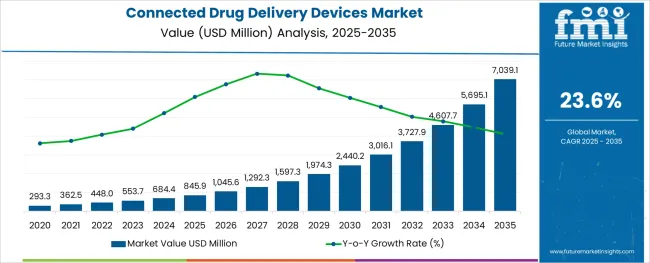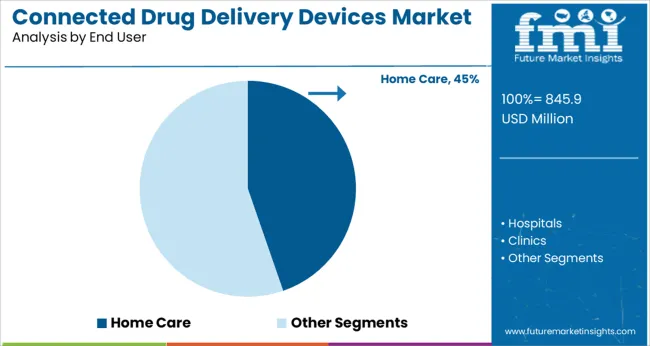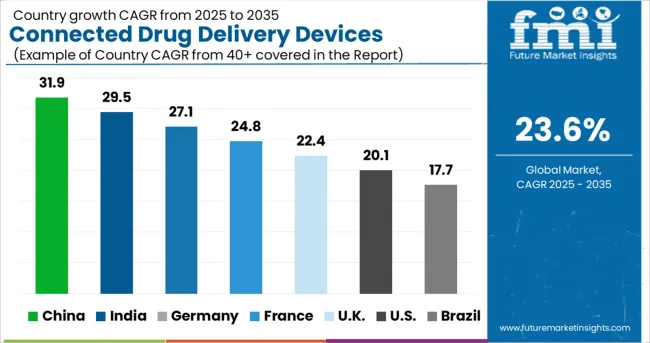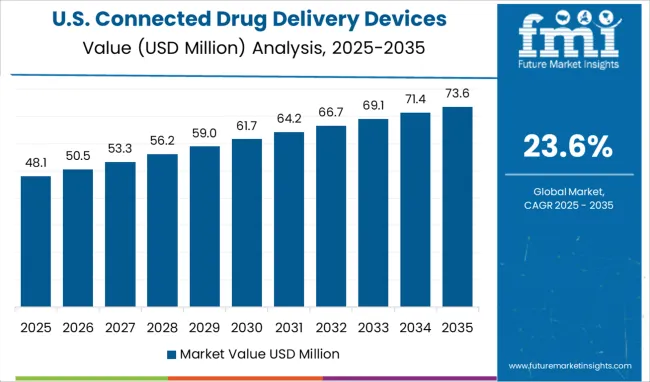The Connected Drug Delivery Devices Market is estimated to be valued at USD 845.9 million in 2025 and is projected to reach USD 7039.1 million by 2035, registering a compound annual growth rate (CAGR) of 23.6% over the forecast period.

The connected drug delivery devices market is expanding rapidly as healthcare shifts toward patient-centric and remote care models. Increasing adoption of digital health technologies has driven demand for devices that offer real-time monitoring and data integration, improving treatment adherence and outcomes.
Home care settings are becoming increasingly important due to the rising prevalence of chronic diseases and patient preference for managing conditions outside hospitals. Innovations in device connectivity and interoperability have enhanced the ability of healthcare providers to remotely monitor therapy and adjust dosing.
Regulatory encouragement for digital health solutions and increased awareness of the benefits of connected devices have further accelerated market growth. The diabetes application segment is expanding due to the global rise in diabetes incidence and the need for effective glucose management tools. Overall, product demand is primarily led by inhalation devices while home care serves as the key end-user segment.
The market is segmented by Product Type, End User, Application, and Technology and region. By Product Type, the market is divided into Inhalation Devices and Injectable Devices. In terms of End User, the market is classified into Home Care, Hospitals, and Clinics.
Based on Application, the market is segmented into Diabetes, Anaphylaxis, Cardiovascular, Hormone Replacement, and Others. By Technology, the market is divided into Bluetooth Drug Delivery Devices and Near Field Communication Drug Delivery Devices. Regionally, the market is classified into North America, Latin America, Western Europe, Eastern Europe, Balkan & Baltic Countries, Russia & Belarus, Central Asia, East Asia, South Asia & Pacific, and the Middle East & Africa.
The market is segmented by Product Type, End User, Application, and Technology and region. By Product Type, the market is divided into Inhalation Devices and Injectable Devices. In terms of End User, the market is classified into Home Care, Hospitals, and Clinics.
Based on Application, the market is segmented into Diabetes, Anaphylaxis, Cardiovascular, Hormone Replacement, and Others. By Technology, the market is divided into Bluetooth Drug Delivery Devices and Near Field Communication Drug Delivery Devices. Regionally, the market is classified into North America, Latin America, Western Europe, Eastern Europe, Balkan & Baltic Countries, Russia & Belarus, Central Asia, East Asia, South Asia & Pacific, and the Middle East & Africa.

The inhalation devices segment is projected to hold 51.3% of the connected drug delivery devices market revenue in 2025. This leadership position is driven by the growing use of connected inhalers in managing respiratory diseases such as asthma and chronic obstructive pulmonary disease.
Connected inhalation devices provide accurate tracking of medication usage and enable personalized treatment plans through integrated sensors and mobile applications. Patients benefit from reminders and adherence reports, leading to improved disease control and reduced hospital visits.
The convenience and non-invasiveness of inhalation devices have supported their broad acceptance in both clinical and home care environments. Furthermore, ongoing technological advancements are making these devices more affordable and user-friendly, solidifying their market position.

The home care segment is expected to account for 44.7% of the market revenue in 2025, reflecting the increasing shift towards outpatient and remote healthcare delivery. Connected drug delivery devices are particularly suited for home use as they allow patients to manage chronic conditions with professional oversight without frequent hospital visits.
The segment benefits from growing patient preference for self-administration and monitoring, supported by healthcare providers encouraging decentralized care models. Technological improvements in device connectivity have facilitated seamless data sharing between patients and clinicians, enhancing care quality.
Additionally, the expansion of home care infrastructure and reimbursement frameworks has made connected devices more accessible, driving segment growth.

The diabetes application segment is projected to represent 49.2% of the connected drug delivery devices market revenue in 2025. This segment’s prominence is linked to the global rise in diabetes cases and the need for effective glycemic control tools.
Connected insulin delivery devices, such as smart pens and pumps, provide real-time data and analytics that support personalized therapy adjustments. These devices reduce the risk of dosing errors and improve adherence, which are critical for managing diabetes complications.
Increased awareness among patients and healthcare professionals about the benefits of connected diabetes management solutions has further fueled demand. Ongoing innovations aiming to integrate continuous glucose monitoring with drug delivery systems are expected to sustain the segment’s growth momentum.
| Particulars | Details |
|---|---|
| H1, 2024 | 25.73% |
| H1, 2025 Projected | 23.59% |
| H1, 2025 Outlook | 22.79% |
| BPS Change - H1, 2025 (O) - H1, 2025 (P) | (-) 80 ↓ |
| BPS Change - H1, 2025 (O) - H1, 2024 | (-) 294 ↓ |
With the influence of various macroeconomic, industrial and regulatory variables, the comparative analysis of market growth rate of global connected drug delivery devices market has been studied by Future Market Insights.
As per the study, the global market will show a negative BPS growth in H1-2025 outlook as compared to H1-2025 projected period by 80 BPS, and, a decline in BPS growth is expected in H1-2025 over H1- 2024 duration with 294 Basis Point Share (BPS).
Key barriers to the broader adoption of connected devices include data privacy laws that may prevent data sharing with HCPs in some countries, as well as the need to demonstrate that the tools are consistently used and generate a high-quality and reproducible database. These factors impose a negative impact as observed in the BPS value change.
However, there are some positive factors that will help push the market growth in the upcoming years which includes growing development of connected drug delivery systems with features like adherence trackers, patient education tools, dose reminders, patient diaries to gather patient-reported outcomes, and monitoring systems with interfaces between patients and healthcare professionals (HCPs).
This will enable patient monitoring and counselling in a home setting, thereby providing lucrative growth opportunities for the market players.
The healthcare industry has seen major changes over the past years, and most of these were driven by increased technological proliferation in the industry.
Drug delivery has become one of the most researched areas in the healthcare industry, and since patient engagement has become essential in the medical sector, demand for connected drug delivery devices has also risen significantly.
Injectable drug delivery devices are expected to be most popular over the next few years as they have multiple functionalities and can be used for drug tracking, drug delivery, as well as drug identification.
Rising preference for these among the population is expected to boost sales of injectable drug delivery devices over the forecast period.
Rising penetration of IoT (Internet of Things) in the medical industry, advances in drug delivery nanotechnology, innovative product launches, increasing awareness about connected drug therapy, and rising trend of home care are some of the major factors that are positively influencing the sales of connected drug delivery devices across the globe.
Demand for connected drug delivery devices increased at a phenomenal CAGR of 26.3% from 2020 to 2024, and is slated to continue surging at 23.6% CAGR from 2025 to 2035,
This research details the global connected drug delivery devices industry across North America, Latin America, Europe, East Asia, South Asia & Pacific, and the Middle East & Africa (MEA).
The North America connected drug delivery devices market, which is set to hold a significant market share of 51.5% in 2025, is expected to maintain this dominance over the forecast period as well.
Increasing healthcare expenditure and rising awareness are majorly propelling the sales of connected drug delivery devices in the region.
The market for connected drug delivery devices in Europe holds the second-highest market share of over 28%. Demand for connected drug delivery products in Europe is expected to rise at the fastest CAGR among all regions. Rapid growth can be attributed to increasing prevalence of chronic diseases in the region.
Market growth of connected drug delivery devices in East Asia, South Asia, and the Pacific is expected to see limited due to major factors influencing the sales and adoption of connected drug delivery devices. Majorly, high cost of connected drug delivery devices is restraining the market potential in these regions.
Connected drug delivery system manufacturers can target these regions to gain from the untapped market potential with competitive pricing and affordable products.
The connected drug delivery devices market in the MEA region, which merely contributes 1.9% to the global market share, is expected to rise at a sluggish CAGR. This is majorly due to high costs and little to no awareness about connected drug delivery devices.
However, as the region develops, it would offer some good opportunities for manufacturers and distributors of connected drug delivery devices to boost their sales.

The Japanese connected drug delivery devices market in 2025 is slated to hold 5.1% share of the global market. The nation is always regarded as one of the most technologically advanced in the world, and it only befits that Japan is leading the adoption of healthcare and medical technologies than most nations.
Japan has very high technological proliferation in the healthcare sector, and this makes it a very lucrative market for connected drug delivery device suppliers.Demand for connected drug delivery equipment is also expected to be boosted by the rising geriatric population in Japan, which is also fuelling demand for home care solutions in the nation.
Sales of connected drug delivery systems are expected to see a rise over the forecast period as the popularity and effectiveness of these devices rise.

The healthcare industry in the USA has been experiencing great growth over the past few years, and is expected to continue to do so over the forecast period as well. The nation has seen substantial increase in the adoption of connected drug delivery equipment.
Factors such as high per capita healthcare spending, rising adoption of new medical technologies, and increasing awareness about the adverse effects of non-compliance with drug therapy are majorly driving the sales of connected drug delivery products in the USA
| Attribute | Details |
|---|---|
| Forecast Period | 2025 to 2035 |
| Historical Data Available for | 2020 to 2024 |
| Market Analysis | USD Million for Value, Units for Volume |
| Key Regions Covered | North America; Latin America; Europe; East Asia; South Asia & Pacific; Middle East & Africa (MEA) |
| Key Countries Covered | United States, Canada, Brazil, Mexico, Germany, UK, France, Spain, Italy, China, Japan, South Korea, India, Indonesia, Malaysia, Singapore, Australia, New Zealand, Turkey, South Africa, and GCC Countries |
| Key Market Segments Covered | Product Type, End User, Application, Technology, Region |
| Key Companies Profiled | Bayer AG.; Propeller Health; West Pharmaceutical Services Inc.; 3M Company; OPKO Health; Sagentia (Science Group); Care TRx; CeQur SA; Biocorp Production SA |
| Pricing | Available upon Request |
The global connected drug delivery devices market is estimated to be valued at USD 845.9 USD million in 2025.
It is projected to reach USD 7,039.1 USD million by 2035.
The market is expected to grow at a 23.6% CAGR between 2025 and 2035.
The key product types are inhalation devices, injectable devices, _handheld injectable devices and _wearable injectable devices.
home care segment is expected to dominate with a 44.7% industry share in 2025.






Full Research Suite comprises of:
Market outlook & trends analysis
Interviews & case studies
Strategic recommendations
Vendor profiles & capabilities analysis
5-year forecasts
8 regions and 60+ country-level data splits
Market segment data splits
12 months of continuous data updates
DELIVERED AS:
PDF EXCEL ONLINE
Connected Sensors Market Size and Share Forecast Outlook 2025 to 2035
Connected Diagnostics Market Size and Share Forecast Outlook 2025 to 2035
Connected RHM (Remote Healthcare Monitoring) Market Size and Share Forecast Outlook 2025 to 2035
Connected Aircraft Market Size and Share Forecast Outlook 2025 to 2035
Connected Packaging Market Size and Share Forecast Outlook 2025 to 2035
Connected Living Room Market Size and Share Forecast Outlook 2025 to 2035
Connected Toys Market Size and Share Forecast Outlook 2025 to 2035
Connected Vehicle Technology Market Size and Share Forecast Outlook 2025 to 2035
Connected Tire Market Size and Share Forecast Outlook 2025 to 2035
Connected Logistics Market Growth - Trends, Demand & Innovations 2025 to 2035
Connected Game Console Market Analysis by Product Type, Application, and Region through 2035
Understanding Connected TV Market Share & Growth Trends
Connected TV’s Market Outlook 2025 to 2035
Connected Healthcare Market
Connected Car Market Growth – Trends & Forecast 2024-2034
AI-Driven Smart Home Appliances – Enhancing Home Automation
Connected Lighting Platform Market
Connected Enterprise Video Surveillance Solutions Market
Connected Energy Market
Connected Solutions for Oil & Gas Market Insights – Trends & Forecast 2020-2030

Thank you!
You will receive an email from our Business Development Manager. Please be sure to check your SPAM/JUNK folder too.
Chat With
MaRIA